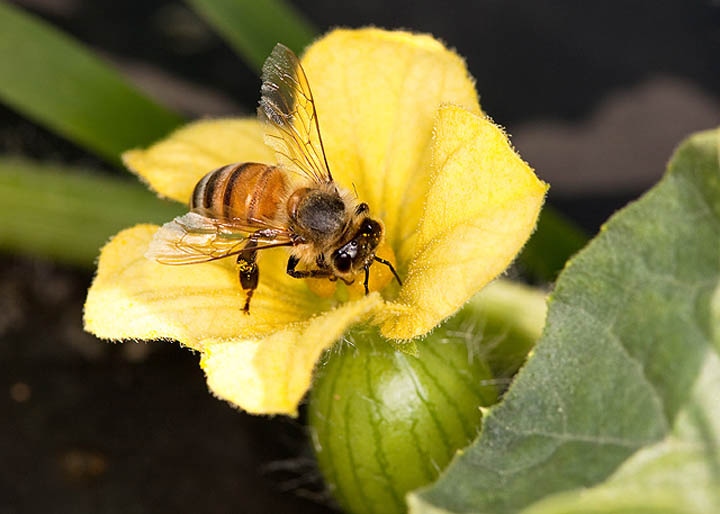January 7, 2013

Grab the bear bottle of honey off the Walmart shelf and have a look. By appearance, the honey looks golden and wholesome. The beehive the honey came from may contain 60,000 honey bees; and those same bees probably tapped over a million flowers to make it. Odds are the honey is golden and sweet — but about as pure as the bottom of the Chinese barrel it shipped in.
Honey, due to foreign imports, is one of the most tainted foods in America, and China has a sticky finger in almost every pot. The fix is in and China has essentially set up a network of honey chop shops to the tune of billions in profit. Honey counterfeiting is not just “under-the-table business as usual,” but relates directly to U.S. food security issues. Honey bees pollinate $20 billion worth of American crops each year — and a strong honey industry is vital to the U.S. food supply.
Americans consume more honey than any nation on Earth — over 400 million pounds a year when home/restaurant use, baked items, and processed foods are all factored in. But the U.S. honey industry meets less than half of the demand, and that’s where China, the world’s No. 1 honey producer, factors in.
In 2001, the U.S. claimed China was dumping on the American market and hit Chinese honey with a major tariff — $1.20 per pound. It wasn’t only a matter of protecting U.S. producers — the Chinese honey was, and is, “dirty.” The laundered Chinese honey often contains harmful antibiotics, lead, molasses, fructose, farm chemicals, or whatever masking agent the Chinese will think up next.
Yet, even with a laundry list of harmful ingredients and a $1.20 duty, Chinese honey is still on American grocery shelves and doesn’t appear to be going away anytime soon.
Despite the tariff, China runs a cartel of global honey laundering — a kingpin’s world of shady middlemen, unknown ingredients, doctored labels, fake manifests, and heavyweight corporate execs. China’s underground honey operation is a billion-dollar success and ranks as one of the most profitable food scams in history.
Sidestepping the $1.20 tariff, China sends its honey to a long list of Asian countries (particularly India) not subject to the U.S. import penalty. The Chinese honey is then given fake labels and point-of-origin documents, routinely repackaged and mixed with other honey, loaded on containers, and dropped into the U.S. market. The chop shop approach often results in ultra-filtrated honey: Pollen traces are literally removed, making the honey untraceable. But the process also leaves the honey devoid of color and taste. Solution? The chop shops just stir in extra honey made in India or Vietnam.
Honey pipeline
Texas A&M’s Vaughn Bryant, the U.S. guru of pollen detection, studied 60 honey samples from major retailers across 10 different states in 2011. Bryant’s findings showed that three-quarters of the honey samples had undergone the ultra-filtration process.
Despite a mountain of evidence of complicity, China’s Asian pipeline partners deny the undeniable. India has doubled down, and with angelic insistence, claims it has merely ramped up domestic honey production — a “cat that ate the canary” approach.
The FDA has often appeared hapless and about three steps behind the Chinese shell game. With billions of dollars at stake, the Chinese pipeline will continue flooding the U.S. market with tainted honey in 2013. Cracking down on the Chinese laundering sites overseas is a cat-and-mouse affair, but the exit points of the pipeline in the U.S. can be shut down. In 2006, the U.S. government went after the Alfred L. Wolff (ALW) company for illegal honey imports; ALW is a major food corporation headquartered in Germany. Regarding ALW, OPEN magazine reported that: “According to a 44-count indictment of the firm, over 2004-06, it laundered over 2 million pounds — 900 tonnes — of Chinese honey through India, evading nearly $80 million in duties.”
Eighty million dollars in a three-year span — a sobering number. The U.S. honey industry is in genuine crisis and the U.S. government should go after more companies like ALW. There are a dozen or so major conglomerates importing honey into the U.S. market. Which ones are on the Chinese pipeline?
Twitter: @CBennett71
More from Western Farm Press
PETA drones a trophy prize for US hunters
Demon seeds: Searching for the planet's hottest pepper
Biggest wine hoax in history reveals trade secrets
Farm murders met with media silence
You May Also Like




